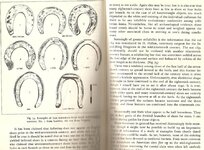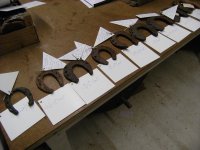Vldetecting
Sr. Member
- Jun 23, 2017
- 413
- 897
- Detector(s) used
- Garrett AT Max, Garrett AT Pro-Pointer, Garrett Ace 250
- Primary Interest:
- All Treasure Hunting
Iv'e seen many people asking about how to date horseshoes. Many say it is nearly impossible, but I say it's not. So I thought about sharing a little "guide" on how to date horseshoes.
First of all, here is a small guide with pictures & dates for more american horseshoes:

As you can see the older ones are more plain and simple with larger horseshoe-nail holes. They are also very thick compared to the newer ones. Another thing you can look for is the quality of the horseshoe. In 1835 the first horseshoe manufacturing machine was patented in the United States by Henry Burden. And since c. 1850's-60's the horseshoe was mostly manufactured. It means that the more modern horseshoes are more 'perfect' shaped and the more older ones will not be as perfect shaped as the modern ones.
Here is another picture of more older horseshoes with dates:

The older medieval horseshoes are more often found in Europe, and the oldest nail horseshoes ever found is from ca. 10th century. In more modern horseshoes (ca. 16th century to now) there is often eight horseshoe-nail holes in the horseshoe. But in older horseshoes (ca. 10th to 16th century.) there is more often six horseshoe-nail holes in the horseshoe. It means that if you find a six holed horseshoe it will probably be an very old horseshoe and it is probably older than the 17th century. The older horseshoes were also more lightweight and had scalloped outer rims. That's also some useful information.
I hope this information will be useful to you for the next time you find and older horseshoe
And if you want to know a little bit more history behind the horseshoe check out these links below:
https://en.wikipedia.org/wiki/Horseshoe#History
https://dressagetoday.com/uncategorized/history-of-horseshoes-17802
Horseshoe - History of Horseshoe
First of all, here is a small guide with pictures & dates for more american horseshoes:

As you can see the older ones are more plain and simple with larger horseshoe-nail holes. They are also very thick compared to the newer ones. Another thing you can look for is the quality of the horseshoe. In 1835 the first horseshoe manufacturing machine was patented in the United States by Henry Burden. And since c. 1850's-60's the horseshoe was mostly manufactured. It means that the more modern horseshoes are more 'perfect' shaped and the more older ones will not be as perfect shaped as the modern ones.
Here is another picture of more older horseshoes with dates:

The older medieval horseshoes are more often found in Europe, and the oldest nail horseshoes ever found is from ca. 10th century. In more modern horseshoes (ca. 16th century to now) there is often eight horseshoe-nail holes in the horseshoe. But in older horseshoes (ca. 10th to 16th century.) there is more often six horseshoe-nail holes in the horseshoe. It means that if you find a six holed horseshoe it will probably be an very old horseshoe and it is probably older than the 17th century. The older horseshoes were also more lightweight and had scalloped outer rims. That's also some useful information.
I hope this information will be useful to you for the next time you find and older horseshoe

And if you want to know a little bit more history behind the horseshoe check out these links below:
https://en.wikipedia.org/wiki/Horseshoe#History
https://dressagetoday.com/uncategorized/history-of-horseshoes-17802
Horseshoe - History of Horseshoe












